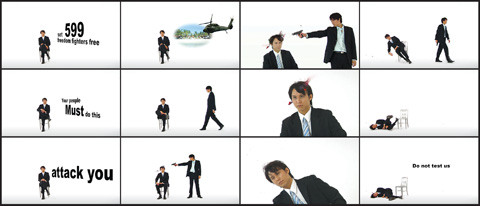The Taishin Art Awards (台新藝術獎) ceremony was held on Saturday at Taishin Bank’s slick new office tower on Renai circle. Tsui Kuang-yu’s (崔廣宇) video installation The Shortcut to the Systematic Life — Invisible City (系統生活捷徑 — 城市瞎摸) picked up the top prize in the visual art category.
The Taishin Bank Foundation for Arts and Culture (台新銀行文化藝術基金會) handed out NT$1 million in cash prizes in two categories. The prizes are only small brush strokes on a large canvas that seeks to show off some of Taiwan’s best contemporary art.
Becky Cho (曹鸞姿), the foundation’s director, said Tsui is representative of Taiwan’s contemporary artists because he is young, works in new media and is adept at networking.

PHOTO COURTESY OF MOCA, TAIPEI
“It takes a lot to be an artist now,” Cho said. “The art environment has become more than just point-to-point. It’s more like a web. You don’t just own a studio or show your work once a year and just talk to one guy that is your agent. You really have to go out and meet people and do a lot of networking.”
Cho said that networking determines, to a large extent, how the awards’ international jury is chosen.
The jury is made up of three groups. The judging process begins with a “nominating committee,” which is a group made up of local reporters, critics and academics that frequent galleries, museums and festivals across the island. This “frontline group,” as Cho calls it, reports back to a “review committee” every three months, which whittles down contenders and produces a shortlist that is passed on to the international jury.
Cho said international jurors are selected on their ability to promote Taiwanese art abroad. Cho networks with local foreign institutes in Taiwan and seeks their input in choosing the international jurors.
“We want [international jurors] to come to Taiwan to pick work that they think they could bring to their own country,” she said.
Two other rules determine the composition of the jury. The first is that the international jurors should have never been to Taiwan. This ensures that the awards introduces Taiwanese contemporary art to new audiences. The other is that the festival directors should not be attached to a mainstream institution, which is conducive to promoting more radical contemporary art.
“These works push the envelope and are not mainstream … . I have found there is a trend of encouraging edgy work and even underground work — work that would not necessarily be promoted otherwise,” Cho said.
The Taishin Art Awards includes a performance art category. Horse Dance Theater (驫舞劇場) took top honors with Velocity (速度), a work that investigates through movement the frenetic pace of contemporary urban life. Further information about short-listed nominees can be found at www.taishinart.org.tw.

June 2 to June 8 Taiwan’s woodcutters believe that if they see even one speck of red in their cooked rice, no matter how small, an accident is going to happen. Peng Chin-tian (彭錦田) swears that this has proven to be true at every stop during his decades-long career in the logging industry. Along with mining, timber harvesting was once considered the most dangerous profession in Taiwan. Not only were mishaps common during all stages of processing, it was difficult to transport the injured to get medical treatment. Many died during the arduous journey. Peng recounts some of his accidents in

“Why does Taiwan identity decline?”a group of researchers lead by University of Nevada political scientist Austin Wang (王宏恩) asked in a recent paper. After all, it is not difficult to explain the rise in Taiwanese identity after the early 1990s. But no model predicted its decline during the 2016-2018 period, they say. After testing various alternative explanations, Wang et al argue that the fall-off in Taiwanese identity during that period is related to voter hedging based on the performance of the Democratic Progressive Party (DPP). Since the DPP is perceived as the guardian of Taiwan identity, when it performs well,

A short walk beneath the dense Amazon canopy, the forest abruptly opens up. Fallen logs are rotting, the trees grow sparser and the temperature rises in places sunlight hits the ground. This is what 24 years of severe drought looks like in the world’s largest rainforest. But this patch of degraded forest, about the size of a soccer field, is a scientific experiment. Launched in 2000 by Brazilian and British scientists, Esecaflor — short for “Forest Drought Study Project” in Portuguese — set out to simulate a future in which the changing climate could deplete the Amazon of rainfall. It is

The Taiwan People’s Party (TPP) on May 18 held a rally in Taichung to mark the anniversary of President William Lai’s (賴清德) inauguration on May 20. The title of the rally could be loosely translated to “May 18 recall fraudulent goods” (518退貨ㄌㄨㄚˋ!). Unlike in English, where the terms are the same, “recall” (退貨) in this context refers to product recalls due to damaged, defective or fraudulent merchandise, not the political recalls (罷免) currently dominating the headlines. I attended the rally to determine if the impression was correct that the TPP under party Chairman Huang Kuo-Chang (黃國昌) had little of a